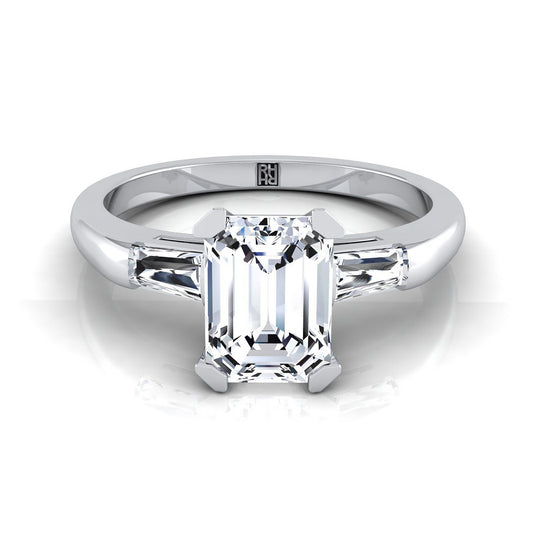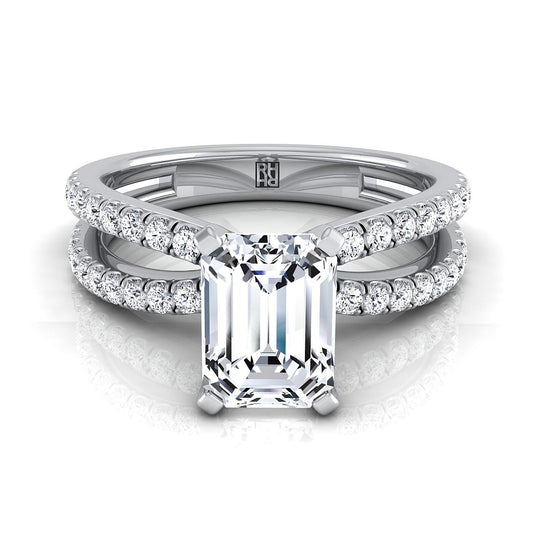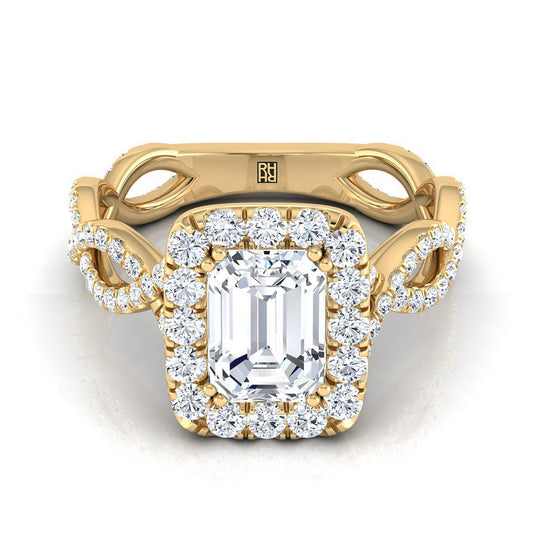Buyer's Guide to Emerald Gemstones
-
Buyer's Guide to Emerald Gemstones
SHOP EMERALD RINGSEmerald is the gemstone of Venus, the goddess of love. From Cleopatra to Elizabeth Taylor, the actress who most famously portrayed her, emeralds make the world's most beautiful women even more stunning.
What do you give the woman you love when the world wouldn't be enough? King Edward gave up his throne and gave Wallis Simpson an emerald engagement ring and the title of Duchess of Windsor. Jack Kennedy gave Jacqueline Bouvier an emerald engagement ring and the White House.
Emeralds are a meaningful gemstone choice for an engagement ring because they symbolize love and rebirth. With the rich green of spring, emerald is the gemstone of new beginnings. In this buying guide, we’ll look at why emerald is valuable and everything you need to know about how to buy an emerald that you will love. -
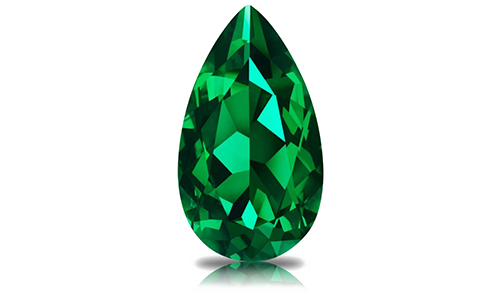
-
The History of Emerald
The word emerald comes from the Greek word smaragdos, which means “green stone.” Emerald is the green color of the mineral beryl, with a vivid color caused by trace amounts of chromium or vanadium. Other gemstones in the beryl family that are related to emerald are pastel blue aquamarine and pastel pink morganite.
Every culture that discovered emerald gemstones fell in love. The first known emerald mines were in Egypt. Today you can visit the ruins of what are popularly known as Cleopatra's Mines in the Wadi El Gamal National Park south of Marsa Alam. Most historians think these ancient emerald mines date back at least to 300BC and probably even a thousand years earlier. The Romans called the area Smaragdus Mons or Emerald Mountains.
According to The Egyptian Book of The Dead, emeralds are a gift from Thoth, the God of Wisdom. Because emeralds symbolize rebirth, mummies were buried with an emerald gemstone placed at their throat to provide protection during the journey through the underworld and a new beginning in the afterlife.
As a symbol of eternal youth, emeralds were a particular favorite of the last queen of Egypt, Cleopatra. Not only did the queen often wear emerald gemstones herself, she presented at least one ambassador with her portrait carved into an emerald.
In the New World, the Incas mined emerald in what is now Colombia since at least the year 1000 for use in religious artifacts and jewelry. When the Spanish reached South America, they loaded their treasure galleons to return to Spain with high quality emeralds finer than any ever seen in Europe before.
-
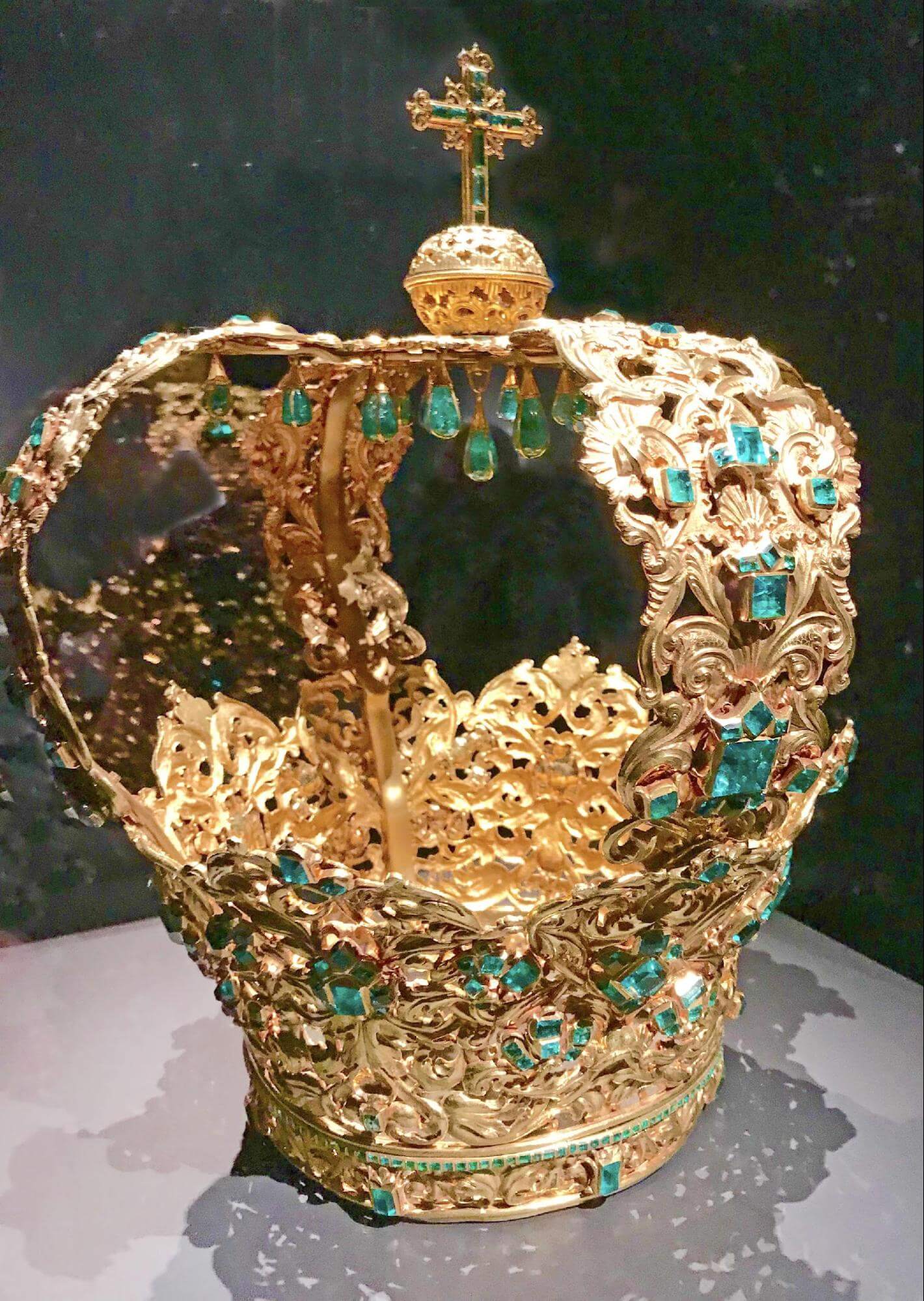
The 46-carat emerald that adorns the Crown of the Andes, one of 447 emeralds set in 100 pounds of gold, is said to have been part of the ransom Incan emperor Atahualpa paid to Francisco Pizarro. The Crown is now in the collection of the Metropolitan Museum of Art in New York.
-
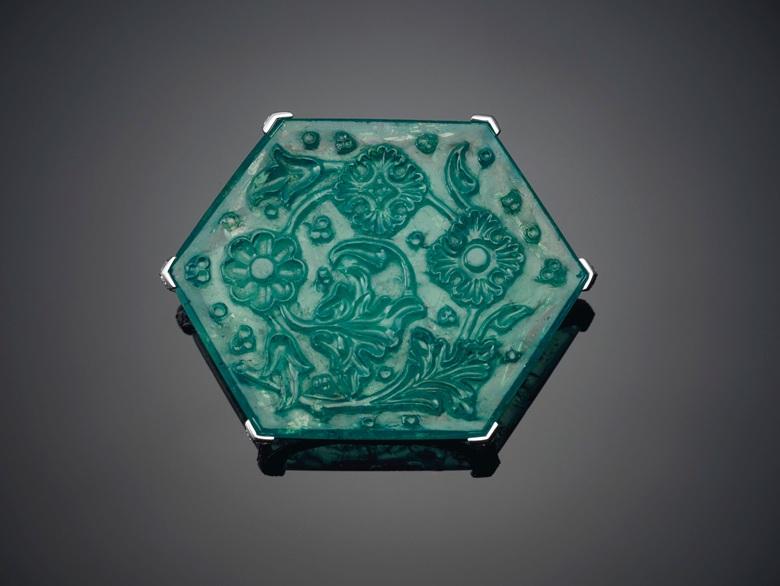
The Mughal rules of India prized emerald as the gem of paradise. They imported thousands of carats of Colombian emeralds to create some of the world’s most fantastic emerald jewelry. They wore emeralds carved with leaves and flowers and inscribed with prayers and the names of their owners. Emeralds adorned their swords, thrones, statues and household objects.
-
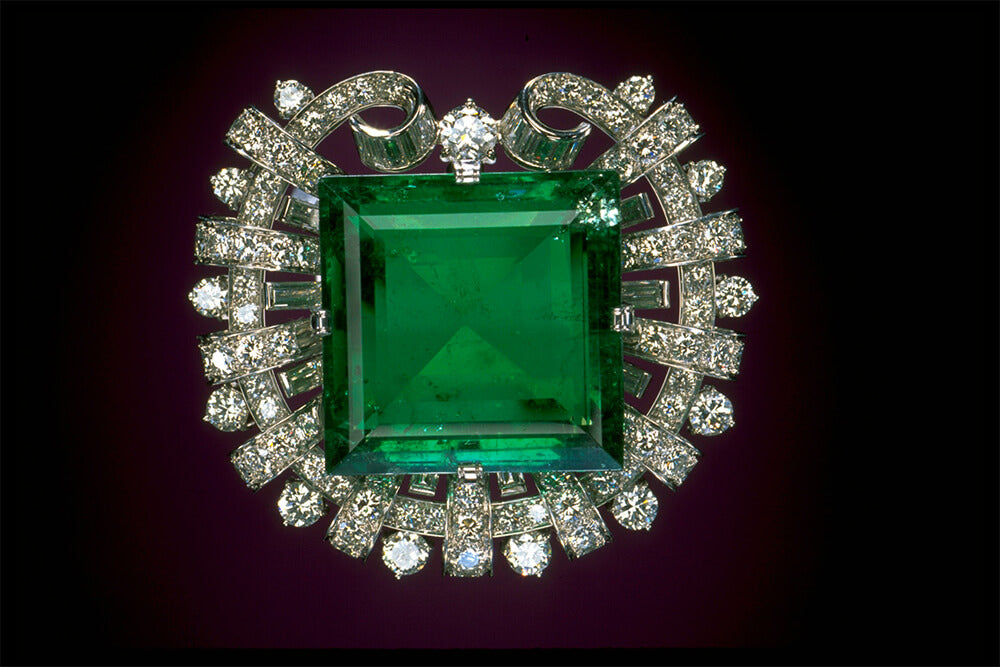
The sultans of the Ottoman Empire also treasured emeralds. The 75.47-carat Hooker Emerald, now in the collection of the Smithsonian National Museum of Natural History, was once set in the belt buckle of Ottoman Sultan Abdul Hamid II, the last sultan of the Ottoman Empire.
-
Where Emeralds are Mined
The emerald mines of Colombia are still the most important source of high quality emeralds today. Colombian emeralds have a rich green color that glows in sunlight. Muzo has been the most important Colombian emerald mine for centuries.
High quality emeralds are also mined in Brazil and Afghanistan. Brazilian emeralds are often lighter in color than Colombian emeralds. Afghan emeralds are similar in color to Colombian emeralds but are less common in the market.
Emeralds are also mined in Africa. The most well-known African emerald mine is in Zambia. Zambian emeralds often have exceptional clarity for emeralds and a rich dark bluish green color caused by vanadium, rather than the chromium found in Colombian emeralds. Most Zambian emeralds come from the Kagem Mine which is 75% owned by Gemfields, with the rest owned by the Zambian government. Gemfields emphasizes responsible mining practices.
Zimbabwe produces small emeralds known as Sandawana emeralds that are famous for top quality color in small sizes. A recent find in Ethiopia is also producing high quality emeralds.
In general, the origin of an emerald isn't an important value factor. Although Colombian emeralds generally sell for more than emeralds from other countries, the premium is also based on the quality of the color not just the origin alone. GIA and other laboratories issue origin reports for emeralds.
-
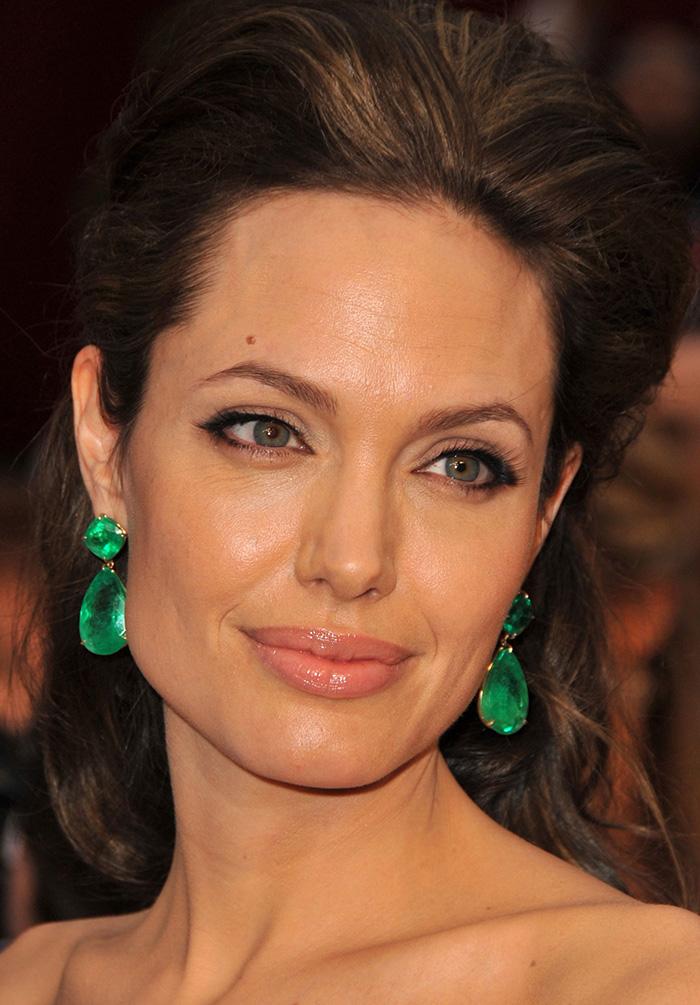
Take the emerald drop earrings Angelina Jolie wore to the Oscars with a simple strapless black dress. Ordinary diamond drops could never have the same impact. (Sales for the green gems surged overnight.)
But even in more modest sizes, emeralds always remind you of Spring. And like the way that the green leaves in a beautiful garden offset the colors of each blossom, emeralds harmonize with every color in your wardrobe.
There’s one other thing that makes emerald easier to buy than other gemstones. It’s bigger than you think. Emerald’s specific gravity, or density, is relatively low. That means an emerald with a one-carat weight is noticeably larger in size than a one-carat weight diamond. Its color also makes it more dramatic.
Emerald is the birthstone for the month of May and the gemstone for 20th wedding anniversaries. But no matter your birthstone or year of marriage, emeralds are your gemstone if the color speaks to you.
-
How to Buy Emerald
Unlike diamonds, colored gemstones aren’t graded for quality by the GIA. Colored gemstone lab reports only identify origin, carat weight, and treatment.
But the most important quality factor for emerald is easy to see: the emerald’s color. Look for a fresh vivid green, like grass after a spring rain. The most desirable emerald colors are bluish green to pure green, with vivid color saturation and tone that’s not too dark.
Emerald clarity is much less important. Natural emeralds almost always have many eye-visible inclusions, known as the jardin (from the French for garden) that grows along with the crystal. Mined natural emeralds are almost never flawless: that’s why most jewelers don’t recommend emeralds for engagement rings. Although emerald itself is relatively hard and durable, the inclusions and fissures of its internal landscape can introduce weakness into its crystal structure.
The emerald treatment known as fracture filling makes these inclusions less visible. Most natural emeralds have surface-reaching fissures filled with an oil, resin or polymer that increases the emerald’s apparent transparency. This emerald treatment can camouflage cavities or fractures that make the emerald vulnerable to knocks and blows. These fillers may need to be replaced over time.
That’s why at RockHer we offer lab-grown emeralds that have almost no eye-visible inclusions. (These man-made emeralds, invented in San Francisco in 1938 by chemist Carroll Chatham, are also known as created emeralds or synthetic emeralds.) Lab-grown emeralds are actual emeralds, the same mineral with identical chemical, physical and optical properties. The only difference is that they are grown in a laboratory instead of mined from the earth. Lab-grown emeralds have a much higher clarity that all but the highest quality mined emeralds. No fillers or treatment is needed to hide inclusions. You can enjoy the color and beauty of emerald without worrying about the lack of durability from fractures that might weaken the crystal.
We think the quality and beauty of our lab-grown emeralds make them a better choice for an engagement ring that will be worn every day than most mined natural emeralds. Only an identification report from a laboratory like GIA can separate a lab-grown emerald from a mined emerald: not even a jeweler can tell just by looking at the gemstone.
At RockHer, we’ve matched our preferred lab-gown emerald colors to Pantone’s system to communicate the rich green of their hue. Which green is your favorite?
-

When judging an emerald’s cut, look for lively brilliance that sparkles evenly across the entire emerald with no dull, washed out, or lifeless areas. You’re most likely to see emerald gemstones cut into an emerald cut: the only cut named after a gemstone variety. The emerald cut is an octagonal step cut that was created to make the most of the shape of the emerald rough and eliminate sharp corners that might chip.
Emeralds are also cut in the smooth domed cabochon shape inspired by ancient jewelry. Small emeralds will be cut in the round brilliant shape and oval shape as well as emerald cuts and are beautiful in eternity bands and also as accent gems. Other fancy shapes will be a bit more difficult to find in larger carat weights.
-
How to Care for Emerald
Emerald jewelry is best cleaned with warm, sudsy water and a tightly woven microfiber cloth. Although emeralds have a hardness of 7.5 to 8 on the Mohs scale, inclusions can make them vulnerable to chipping. Emerald jewelry should be stored in a padded container and not be exposed to high heat or pressure, which could affect the fillings. Never use an ultrasonic machine or steam to clean emerald jewelry or allow a jeweler to clean your emerald jewelry with a machine. Emeralds should always be removed from their setting when your jewelry is resized or repaired.
-
Emerald vs Green Tourmaline vs Tsavorite Garnet
The green colored gemstone most similar in color to emerald is tsavorite, a green garnet found in Tanzania and Kenya. Tsavorite is often more yellow green with less bluish overtones than emerald. Tsavorite is rare in large sizes but can be brilliant and beautiful in small sizes. it’s a good alternative to emerald in pave and eternity bands. Green tourmaline is much more available in large sizes but it is most often found in a dark green hue that’s much darker than emerald green, with dark reflections. Tourmaline is more often a forest green or dark teal than an emerald green. Rare chrome tourmalines have a color that is closer to emerald. If you like dark green hues, tourmaline is a good option that’s more affordable than emerald.
-
Best Emerald Engagement Ring Styles
Our customers’ favorite setting for emerald engagement rings is a halo setting with diamonds that encircle the center stone. The brilliance of the diamonds helps to light up and attract attention to the center emerald. Also popular is a simple emerald solitaire with a delicate pave band. Emerald solitaire rings are generally from one to two carats. Emeralds are also a perfect choice for a three-stone ring, with the emerald either in the center or on the sides. Emerald stud earrings, emerald eternity rings and emerald wedding rings are other great ways to add the fresh green of Spring to everything you wear.
-
What Lab-Grown Emerald Rings Cost
You’d be surprised how far your money can go shopping for a lab-grown emerald engagement ring. Here are our buying guide picks for gorgeous lab-grown emerald rings to fit some common engagement ring budgets.
-
Caroline
14K White Gold Emerald Cut Diamond Three Stone Tapered Baguette Engagement Ring -1/5ctw
Regular price$2,325.83Regular priceUnit price per -
Carole
14K White Gold Emerald Cut Diamond Two Row Pavé Split Shank Engagement Ring -1/3ctw
Regular price$3,158.43Regular priceUnit price per -
Annie
14K Yellow Gold Emerald Cut Diamond Ribbon Twist French Pave Halo Engagement Ring -3/4ctw
Regular price$5,212.33Regular priceUnit price per






